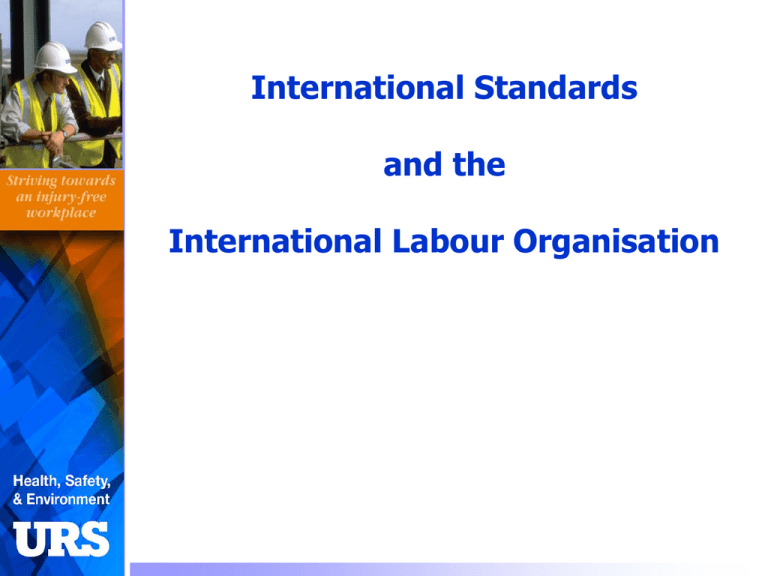
International Standards
and the
International Labour Organisation
History and Goals of the ILO
Industrial Revolution …. World War 1
…Industrialised Countries … Poor working
conditions … High rates of unemployment … :
Constitution of the ILO
(1919)
Set up for:-
Humanitarian reasons
Political reasons
Economic reasons
The Golden Age of Standard Setting
The International Labour
Organisation
and their
Safe Work
philosophy
Safe Work – Priorities
in Industrialised Countries
•Stress
•Ageing workforce
•Right to know
•Chemicals
•Ergonomics
•Management and safety culture
•Occupational health services
•New technologies
•etc.
Safe Work - Priorities
in Developing Countries
•Agriculture
•Other dangerous occupations
•Major accidents and fires
•Safety, housekeeping and
productivity
•Silicosis - work related diseases
•Vulnerable groups, child workers
•Transfer of technology
•etc.
ILO Strategies
Classical
approach
ILO Standards (Conventions,
Recommendations, Codes of
Practice) ratified, adapted into
national regulation
Enforcement and advisory
services by Labour Inspection
Knowledge: information
services and research
Advocacy: training, promotion,
partnerships
Alliances, technical cooperation
and twinning, and resource
mobilization
Management system
approach
• At enterprise
level:
ILO-OSH 2001
“Guidelines on
Occupational Safety
and Health
Management
Systems”
• At national level:
National OSH
Programme
ILO - National Indicators
Should be:• Reliable and
valid
• Easily available
• Easily
comprehensible
• Demonstrative
• Instructive
• Part of an integrated
approach towards
better OSH
• Stimulate action for
improvement
• Indicate strong/weak
points of national
OSH system
• Assist in setting
priorities for action
• Used for follow up
National Indicators
Country Profile
National OSH Programme
ILO - Country profile
• Standards should
be prepared at
country level
• Include basic data
on all parameters
with influence on
OSH management
at national and
enterprise level
National Indicators
• Provide practical
information on ongoing
activities at country level
• Enable the country to
identify gaps in the legal,
institutional, administrative
and technical infrastructure
related to the management
of OSH
• Provide means for
improved coordination
among all parties interested
in OSH
Country Profile
National OSH Programme
Occupational Safety and Health
Standards
Conventions and Recommendations
• The development and implementation of
international standards on labour and social
matters is a key function of the International
Labour Organisation
• The standards take the form of Conventions
and Recommendations.
• More than 70 address occupational safety and
health matters.
Conventions
• Conventions are comparable to multilateral
international treaties:
– they are open to ratification by member
States
– once ratified, create specific, binding
obligations.
• A State that has ratified a Convention is
expected to apply its provisions by legislation or
by other appropriate means
• The Government is required to report regularly
on the application of ratified Conventions.
• Conventions that have not been ratified have the
same value as Recommendations.
Recommendations
• Recommendations
action.
offer
guidelines
for
• A Recommendation may elaborate upon the
provisions of a Convention.
• Member States procedural obligations
– to submit to legislative bodies
– to report on the action resulting and to
report occasionally at the request of the
Governing Body
• There are no specific substantive obligations
Summary on Conventions and
Recommendations
• Both influence laws and regulations of
member States.
•
• Many texts have been modeled on the
relevant provisions of ILO instruments
• Drafts of new legislation or amendments
are often prepared with ILO standards in
mind so as to ensure compliance with
ratified Conventions or to permit the
ratification of other Conventions
Four categories of occupational
safety and health standards
• Guiding policies for action.
• Protection in given branches of economic
activity.
• Protection against specific risks.
• Measures of protection.
The Occupational Safety and
Health Convention 1981 No. 155
and Recommendation (No. 164)
• Progressive application of comprehensive
preventive measures
• Adoption of a coherent national policy on
occupational safety and health.
• The responsibility of employers for making
work and equipment safe and without risk
to health
• The duties and rights of workers.
The Occupational Health Services
Convention 1985 (No.161) and
Recommendation (No. 171)
• Occupational health services
– preventive functions
– responsible for advising employers,
workers and their representatives on
maintaining a safe and health working
environment,
– adaptation of work to the capabilities of
workers.
• Emphasis
– roles
– best use of resources and cooperation












